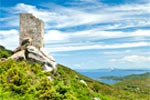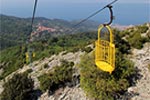The history of Pianosa
The high number of bear, deer and horse fossils found on Pianosa island, attest that even in the Ancient Quaternary Age, the island was welded to the continent. Inhabited by man since the early Paleolithic, it preserves prehistoric signs and important Roman ruins.
The unspoiled nature of Pianosa's coastline, hides a hinterland that has been instead strongly shaped by human activity. Almost all the ancient oak forests have disappeared, in place of cereal fields protected by tuff drywalls, which witness intensified farming and breeding activities since the presence of the agricultural penal colony.
The last 150 years of Pianosa's history are bound to its prison. Pianosa is uninhabited since the prison closed in 1998, when the detainees, the guards, their families and few other civilians who lived there have abandoned the island. The huge wall that stands behind Giovanna Cove, an amazing multicolored sandy beach (the sole in the island), was erected by the will of General Dalla Chiesa in the years of lead, when the super prison of Pianosa housed Mafia members and terrorists.
Pianosa was inhabited since the Paleolithic Age and was later dominated by the Romans. Pianosa is where Augustus banished his nephew Marcus Julius Agrippa Posthumus, who was later killed. In the Middle Ages the island belonged to Pisa, later to Genoa and then the Appiani, who took possession in 1399 and repopulated it. In 1553 the pirates Dragut and Kara Mustafa occupied the island imprisoning all its inhabitants, leaving Pianosa uninhabited until 1635, year in which it returned under the Grand Ducal dominion and became repopulated thanks to the establishment of an agricultural colony; later in 1856 this one turned into a penal colony, a use that was confirmed in 1865 by the Italian government.
The Catacombs
Pianosa preserves some Paleolithic caves in the cape of Punta Secca and the cove of Cala Giovanna, which are evidence of human presence dating back to 18,000 years ago; though its major archaeological treasure is represented by the catacombs, witness of the Christian civilization's dawn. This is a monumental complex which dates between the third and fourth century BC, when the Christians prisoners, victims of Imperial persecutions, were condemned to work in the tuff quarries of the island.
The Roman Villa of Agrippa in Pianosa
The amazing cove Cala Giovanna leads to the unique Roman ruins on the island, Agrippa's villa and its rooms with thermal and marine water. Agrippa was first exiled in the heart of the Tuscan Archipelago by his uncle, the Emperor Augustus, for suspected hostility towards the ruling dynasty and later was killed to ensure the throne to the favored Tiberius. Recently the thermals of Agrippa have been restored and opened to public visitors after a massive and well cared restoration conducted by the Archaeological Superintendence of Tuscany.
The Fort Teglia of Napoleon
On Teglia promontory, facing what is considered to be the most beautiful dock in the world by some, stands Fort Teglia by the will of Napoleon who visited it twice in 1814. The fort thrones over the the nineteenth century small village where the prison's headquarters and the houses of the employees were located. Most of urban works owe their presence to the Emperor who expressed his his cultural eclecticism melting together medieval decorations with oriental and renaissance details.
Elbaworld suggests

What to visit
Discover places and attractions nearby.

Recommended excursions
Discover incredibly beautiful excursions on Elba Island.













